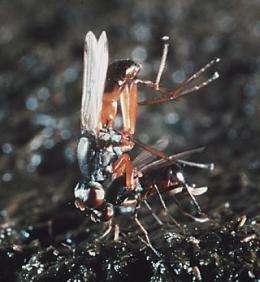European dung-fly females all aflutter for large males

European and North American black scavenger flies – also called dung flies as their larvae develop in the feces of vertebrates and thus break them down – belong to the same species. Nevertheless, they strongly differ in mating behavior and SSD. North American dung fly females are larger than males, the usual dimorphism in insects. European dung flies, however, are more unusual with males being considerably larger than females.
In evolutionary biology, sexual selection for large males can be explained if they can reproduce more successfully than smaller ones, either because females prefer larger males or because the latter prevail more often in the competition for mates with other males. Evolutionary ecologists from the University of Zurich showed that female preference for large males is far greater in European fly populations than in their North American counterparts, which explains the different SSD.
North American dung fly males woo the females with a courtship dance. Project leader Wolf Blanckenhorn does not rule out the possibility that North American males also deploy pheromone-like scents during courtship. This courtship dance is entirely absent in the European flies: males mount the females relatively randomly, cling onto them with varying degrees of success and try to mate with them, even though they are often shaken off again by the females before copulation.
European and North American dung flies also differ in their mating frequency. During their roughly 40-day adult life, European dung flies mate often, their North American counterparts only once or twice. "Frequent copulation requires more sperm from the males and therefore larger testes," explains Blanckenhorn. This could well be a contributory factor in the European females' greater preference for large males. However, the connection between the continental differences in SSD and mating behavior is still unclear: "What is an evolutionary cause and what an effect can only – if at all – be reconstructed indirectly today," concludes Blanckenhorn.
More information: Nalini Puniamoorthy, Martin A. Schäfer and Wolf U. Blanckenhorn. Sexual Selection Account for the Geographic Reversal of Sexual Size Dimorphism in the Dung Fly Sepsis Punctum (Diptera: Sepsidae). Journal Evolution. March 16, 2012. doi:10.1111/j.1558-5646.2012.01599.x
Journal information: Evolution
Provided by University of Zurich


















